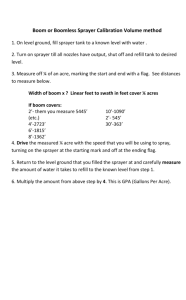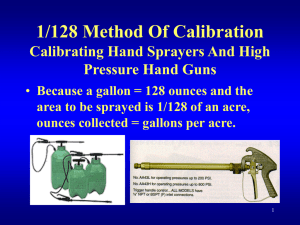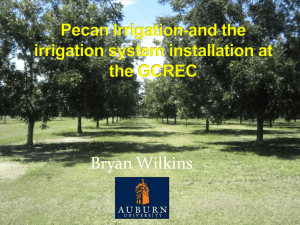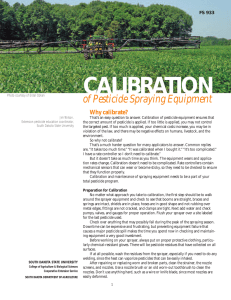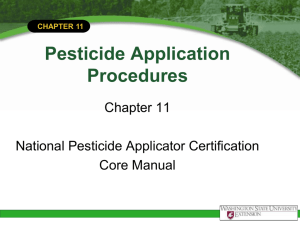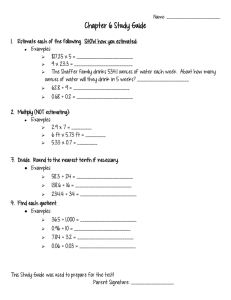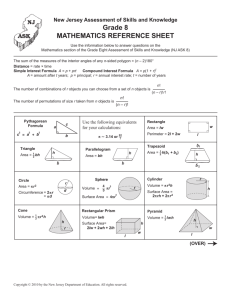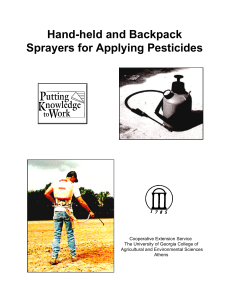1/128 Method of Calibration - University of Wyoming Cooperative
advertisement
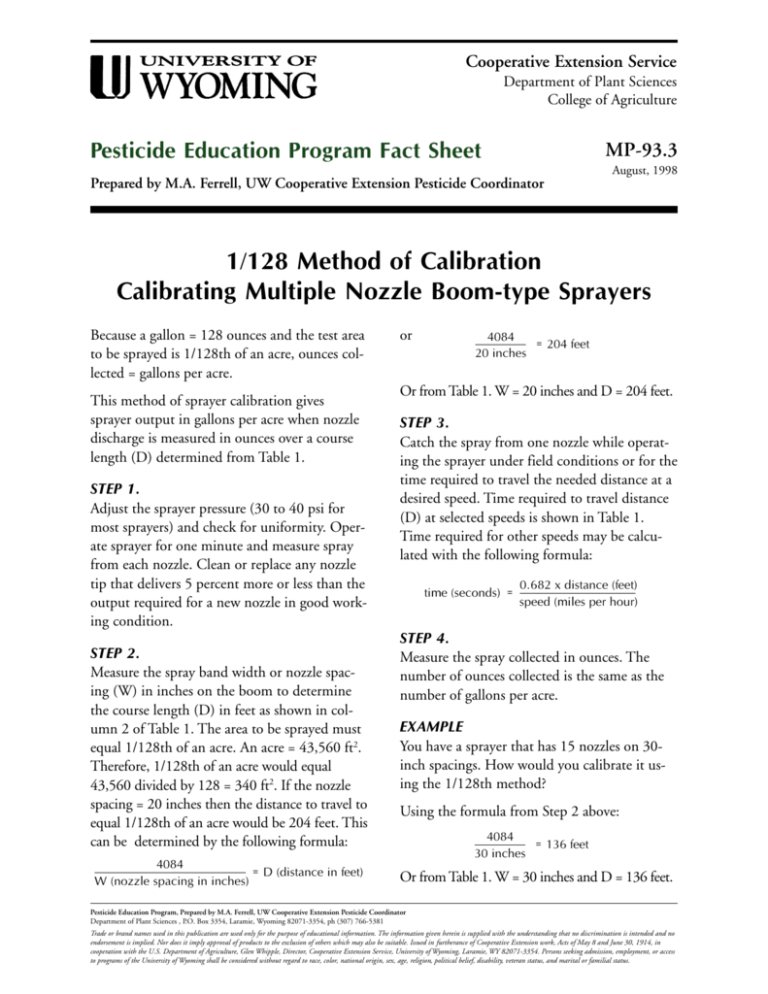
Cooperative Extension Service Department of Plant Sciences College of Agriculture Pesticide Education Program Fact Sheet MP-93.3 Prepared by M.A. Ferrell, UW Cooperative Extension Pesticide Coordinator August, 1998 1/128 Method of Calibration Calibrating Multiple Nozzle Boom-type Sprayers Because a gallon = 128 ounces and the test area to be sprayed is 1/128th of an acre, ounces collected = gallons per acre. This method of sprayer calibration gives sprayer output in gallons per acre when nozzle discharge is measured in ounces over a course length (D) determined from Table 1. STEP 1. Adjust the sprayer pressure (30 to 40 psi for most sprayers) and check for uniformity. Operate sprayer for one minute and measure spray from each nozzle. Clean or replace any nozzle tip that delivers 5 percent more or less than the output required for a new nozzle in good working condition. STEP 2. Measure the spray band width or nozzle spacing (W) in inches on the boom to determine the course length (D) in feet as shown in column 2 of Table 1. The area to be sprayed must equal 1/128th of an acre. An acre = 43,560 ft2. Therefore, 1/128th of an acre would equal 43,560 divided by 128 = 340 ft2. If the nozzle spacing = 20 inches then the distance to travel to equal 1/128th of an acre would be 204 feet. This can be determined by the following formula: 4084 = D (distance in feet) W (nozzle spacing in inches) or 4084 = 204 feet 20 inches Or from Table 1. W = 20 inches and D = 204 feet. STEP 3. Catch the spray from one nozzle while operating the sprayer under field conditions or for the time required to travel the needed distance at a desired speed. Time required to travel distance (D) at selected speeds is shown in Table 1. Time required for other speeds may be calculated with the following formula: time (seconds) = 0.682 x distance (feet) speed (miles per hour) STEP 4. Measure the spray collected in ounces. The number of ounces collected is the same as the number of gallons per acre. EXAMPLE You have a sprayer that has 15 nozzles on 30inch spacings. How would you calibrate it using the 1/128th method? Using the formula from Step 2 above: 4084 = 136 feet 30 inches Or from Table 1. W = 30 inches and D = 136 feet. Pesticide Education Program, Prepared by M.A. Ferrell, UW Cooperative Extension Pesticide Coordinator Department of Plant Sciences , P.O. Box 3354, Laramie, Wyoming 82071-3354, ph (307) 766-5381 Trade or brand names used in this publication are used only for the purpose of educational information. The information given herein is supplied with the understanding that no discrimination is intended and no endorsement is implied. Nor does it imply approval of products to the exclusion of others which may also be suitable. Issued in furtherance of Cooperative Extension work, Acts of May 8 and June 30, 1914, in cooperation with the U.S. Department of Agriculture, Glen Whipple, Director, Cooperative Extension Service, University of Wyoming, Laramie, WY 82071-3354. Persons seeking admission, employment, or access to programs of the University of Wyoming shall be considered without regard to race, color, national origin, sex, age, religion, political belief, disability, veteran status, and marital or familial status. Therefore, you would need to time how long it takes for your sprayer to travel 136 feet. Travel this distance several times in the field and get an average time. Perhaps it takes an average of 31 seconds to cover 136 feet. You would then collect the spray from one nozzle in a container for 31 seconds. Measure the water collected in ounces. The amount collected in ounces equals gallons per acre. If in 31 seconds you collected 20 ounces your sprayer output would be 20 gallons per acre. Determining how much pesticide to add to the spray mixture The recommendation from the label is to apply 1 quart of 2,4-D per acre. The sprayer is applying 20 gallons per acre. Therefore, you will need to add 1 quart of 2,4D to each 20 gallons of water. Your sprayer holds 200 gallons. So how much pesticide will you need to add to the 200 gallon spray tank? 200 gallons divided by 20 gallons = 10 quarts of 2,4-D How large an area can be sprayed by your 200 gallon tank? 200 gallons divided by 20 gallons per acre = 10 acres Table 1. Distance (D) to travel and seconds required for selected speeds when nozzle coverage is (W) inches so that discharge from one nozzle measured in ounces equals gallons per acre. Seconds to travel (D) feet at a speed of: W (in) D (ft) 2 mph 3 mph 4 mph 5 mph 5 817 279 186 139 111 6 681 232 155 116 93 7 583 199 133 99 80 8 510 174 116 87 70 9 454 155 103 77 62 10 408 139 93 70 56 11 371 127 84 63 51 12 340 116 77 58 46 14 292 100 66 50 40 16 255 87 58 43 35 18 227 77 52 39 31 20 204 70 46 35 28 22 186 63 42 32 25 24 170 58 39 29 23 26 157 54 36 27 21 28 146 50 33 25 20 30 136 46 31 23 19 32 128 44 29 22 17 34 120 41 27 20 16 36 113 39 26 19 15 38 107 36 24 18 15 40 102 35 23 17 14
